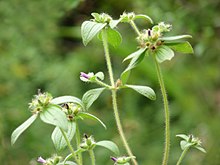Melastomataceae
Ti pamilia ti Melastomataceae (wenno Melastomaceae) ket ti maysa a takson dagiti dicotyledonous nga agsabsabong a mula a kaaduan a mabirukan kadagiti tropiko (dua a pagkatlo dagiti henero ket manipud iti tropiko ti Baro a Lubong) a buklen dagiti c. 165 a henero ken dagiti c. 5115 nga ammo a sebbangan.[2] Dagiti Melastomes ket dagiti tinawen wenno perenial a hierba, dagiti bassit a mula, wenno dagiti bassit a kayo.
| Melastomataceae | |
|---|---|

| |
| Tibouchina semidecandra iti Strybing Arboretum, San Francisco | |
| Taksonomia | |
| Pagarian: | Plantae |
| Klado: | Tracheophytes |
| Klado: | Angiospermae |
| Klado: | Eudicotidae |
| Klado: | Rosids |
| Urnos: | Myrtales |
| Pamilia: | Melastomataceae Juss.[1] |
| Henero-kita | |
| Melastoma | |
| Dagitihenero | |
|
Kitaen ti teksto. | |


Deskripsion urnosen
Dagiti bulong ti melastomes ket naiduma, agsumbangir, agballasiw, ken kadawyan nga agraman kadagiti 3-7 a longitudinal nga urat nga agtaud manipud iti batayan ti bulong, dagiti akin-uneg nga urat ket agbaliw iti ngato ti batayan ti bulong, wenno pinnado nga urat nga agraman kadagiti tallo wenno ad-adu a paris dagiti nangruna nga urat nga agbaliw manipud iti akintengnga nga urat kadagiti agsasaruno a punto iti ngato ti batayan.
Perpekto dagiti sabong, ken mabalin a bugbugtong a rummuar wenno iti terminal wenno axillary, panikulado a cymes.
Ekolohia urnosen
Adda dagiti bilnag ti melastomes a naikeddeng a kas makaraut a sebbangan a dati a naturalisado kadagiti tropikal ken subtropikal nga enbironmento iti ruar ti kadawyan a sakupda. Dagiti pagarigan ket ti lunod ni Koster (Clidemia hirta), Tibouchina semidecandra ken Miconia calvescens, ngem adu pa dagiti mairaman a sebbangan.
Taksonomia urnosen
Babaen ti pannakaidasig ti sistema ti APG III, dagiti pito a henero manipud iti Memecylaceae ket mairamanda itan iti daytoy a pamilia.[1]
Dagiti henero urnosen
- Acanthella
- Aciotis
- Acisanthera
- Acrovena
- Adelobotrys
- Allomaieta
- Allomorphia
- Alloneuron
- Amphiblemma
- Amphitoma
- Amphorocalyx
- Anaectocalyx
- Anerincleistus
- Antherotoma
- Appendicularia
- Arthrostemma
- Aschistanthera
- Astrocalyx
- Astronia
- Astronidium
- Axinaea
- Barthea
- Beccarianthus
- Behuria
- Bellucia
- Benevidesia
- Bertolonia
- Bisglaziovia
- Blakea
- Blastus
- Boerlagea
- Boyania
- Brachyotum
- Brachypremna
- Bredia
- Brittenia
- Bucquetia
- Cailliella
- Calvoa
- Calycogonium
- Cambessedesia
- Campimia
- Carionia
- Castratella
- Catanthera
- Catocoryne
- Centradenia
- Centradeniastrum
- Centronia
- Chaetolepis
- Chaetostoma
- Chalybea
- Charianthus
- Cincinnobotrys
- Clidemia
- Comolia
- Comoliopsis
- Conostegia
- Copedesma
- Creaghiella
- Creochiton
- Cryptophysa
- Cyanandrium
- Cyphostyla
- Cyphotheca
- Dalenia
- Desmoscelis
- Dicellandra
- Dicerospermum
- Dichaetanthera
- Dinophora
- Dionycha
- Dionychastrum
- Diplarpea
- Diplectria
- Dissochaeta
- Dissotis
- Dolichoura
- Driessenia
- Eisocreochiton
- Enaulophyton
- Eriocnema
- Ernestia
- Farringtonia
- Feliciadamia
- Felliciadamia
- Fordiophyton
- Fritzchia
- Graffenrieda
- Gravesia
- Guyonia
- Henriettea
- Henriettella
- Heterocentron
- Heterotis
- Heterotrichum
- Huberia
- Huilaea
- Hylocharis
- Hypenanthe
- Kendrickia
- Kerriothyrsus
- Killipia
- Kirkbridea
- Lavoisiera
- Leandra
- Lijndenia
- Lithobium
- Llewelynia
- Loreya
- Loricalepis
- Macairea
- Macrocentrum
- Macrolenes
- Maguireanthus
- Maieta
- Mallophyton
- Marcetia
- Mecranium
- Medinilla
- Meiandra
- Melastoma
- Melastomastrum
- Memecylon
- Menendezia
- Meriania
- Merianthera
- Miconia
- Microlepis
- Microlicia
- Mommsenia
- Monochaetum
- Monolena
- Mouriri
- Myriaspora
- Myrmidone
- Neblinanthera
- Necramium
- Neodriessenia
- Nepsera
- Nerophila
- Ochthephilus
- Ochthocharis
- Omphalopus
- Opisthocentra
- Oritrephes
- Orthogoneuron
- Osbeckia
- Ossaea
- Otanthera
- Oxyspora
- Pachyanthus
- Pachycentria
- Pachyloma
- Pentossaea
- Phainantha
- Phainanthe
- Phyllagathis
- Pilocosta
- Plagiopetalum
- Pleiochiton
- Plethiandra
- Podocaelia
- Pogonanthera
- Poikilogyne
- Poilannammia
- Poteranthera
- Preussiella
- Pseudodissochaeta
- Pseudoernestia
- Pseudosbeckia
- Pternandra
- Pterogastra
- Pterolepis (Pterolepsis?)
- Rhexia
- Rhynchanthera
- Rousseauxia
- Sagraea (?)
- Salpinga
- Sandemania
- Sarcopyramis
- Schwackaea
- Scorpiothyrsus
- Siphanthera
- Sonerila
- Spathandra
- Sporoxeia
- Stanmarkia
- Stapfiophyton
- Stenodon
- Stussenia
- Styrophyton
- Sussenia
- Svitramia
- Tateanthus
- Tayloriophyton
- Tessmannianthus
- Tetraphyllaster
- Tetrazygia
- Tibouchina
- Tibouchinopsis
- Tigridiopalma
- Tococa
- Topobea
- Trembleya
- Trigynia
- Triolena
- Tristemma
- Tryssophyton
- Tylanthera
- Vietsenia
- Votomita
- Warneckea
Kas makan urnosen
Ti Melastomataceae ket kankanen abbaen dagiti adu nga awan silud nga uyokan, a naipangpangruna babaen ti sebbangan ti Melipona bicolor nga agurnong iti polen manipud iti daytoy a takson ti agsabsabong a mula.[3]
Dagiti nagibasaran urnosen
- ^ a b Angiosperm Phylogeny Group (2009), "An update of the Angiosperm Phylogeny Group classification for the orders and families of flowering plants: APG III", Botanical Journal of the Linnean Society, 161 (2): 105–121, doi:10.1111/j.1095-8339.2009.00996.x, naiyarkibo manipud iti kasisigud idi 2017-05-25, naala idi 2010-12-10
- ^ Christenhusz, M. J. M.; Byng, J. W. (2016). "The number of known plants species in the world and its annual increase". Phytotaxa. Magnolia Press. 261 (3): 201–217. doi:10.11646/phytotaxa.261.3.1.
- ^ Hilário, S. D., and V. L. Imperatriz-Fonseca. "Pollen foraging in colonies of Melipona bicolor (Apidae, Meliponini): effects of season, colony size and queen number." Genetics and Molecular Research 8.2 (2009): 664-671.
Dagiti akinruar a silpo urnosen
Dagiti midia a mainaig iti Melastomataceae iti Wikimedia Commons
Dagiti datos a mainaig iti Melastomataceae iti Wikispecies
- Penneys, D. S.; Michelangeli, F. A.; Judd, W. S.; Almeda, F. (1 Enero 2010). "Henrietteeae (Melastomataceae): A New Neotropical Berry-Fruited Tribe". Systematic Botany. 35 (4): 783–800. doi:10.1600/036364410x539862. JSTOR 40985555.